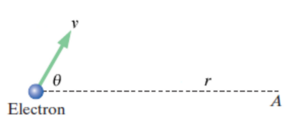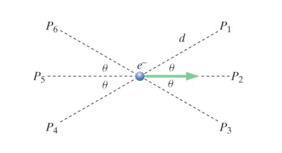Moving Point Charge
Page claimed by James Moroz Jmoroz3 (talk) 11:47, 20 November 2015 (EST)
This page covers the method of calculating the magnetic field from a moving point charge, derived from the Biot-Savart Law for magnetic fields.
The Main Idea
A Mathematical Model
The magnetic field of a moving point charge can be found using a derivation of the Biot-Savart Law for magnetic fields.
With this equation for the magnetic field given some current carrying object, we can rewrited Idl in terms of velocity in order to relate the velocity of the moving particle to the magnetic field at an observation location a distance r from this particle.
With this substitution, the final formula comes out to be:
where q is the charge of the particle, v is the velocity of the moving particle, and r is the distance from the observation location to the moving particle.
Examples
Be sure to show all steps in your solution and include diagrams whenever possible
Simple
At a particular instant, a proton at the origin has velocity < 4e4, -5e4, 0> m/s. Calculate the magnetic field at location < 0.04, 0.05, 0 > m, due to the moving proton.\
Solution:
Since we have both the velocity and magnetic fields as vector coordinates, we must first cross these two as a part of the equation
Middling
The electron in the figure below is traveling with a speed of
[math]\displaystyle{ v = 5*10^6 }[/math]m/s. What is the magnitude of the magnetic field at location A if r = [math]\displaystyle{ 8*10^{-10} }[/math]m and [math]\displaystyle{ \theta=40 }[/math]degrees

Difficult
An electron is moving horizontally to the right with speed [math]\displaystyle{ 5*10^6 }[/math] m/s. What is the magnetic field due to this moving electron at the indicated locations in the figure? Each location is d = 7 cm from the electron, and the angle θ = 35°. Give both magnitude and direction of the magnetic field at each location.
Connectedness
A single moving point charge represents the most simple situation of charges moving in space to produce a magnetic field. In reality, this situation rarely occurs, however understanding how a single moving point charge interacts to produce a field will allow you to understand how sets of moving charges produce a field in space as well.
History
The history of the Biot Savart law and its discovery can be found at the Biot-Savart Law.
See also
Are there related topics or categories in this wiki resource for the curious reader to explore? How does this topic fit into that context?
Further reading
Books, Articles or other print media on this topic
External links
Internet resources on this topic
References
http://maxwell.ucdavis.edu/~electro/magnetic_field/pointcharge.html This section contains the the references you used while writing this page


